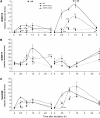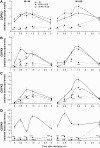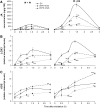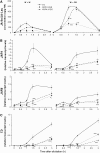Herbivory rapidly activates MAPK signaling in attacked and unattacked leaf regions but not between leaves of Nicotiana attenuata
- PMID: 17400894
- PMCID: PMC1867352
- DOI: 10.1105/tpc.106.049353
Herbivory rapidly activates MAPK signaling in attacked and unattacked leaf regions but not between leaves of Nicotiana attenuata
Abstract
Mitogen-activated protein kinase (MAPK) signaling plays a central role in transducing extracellular stimuli into intracellular responses, but its role in mediating plant responses to herbivore attack remains largely unexplored. When Manduca sexta larvae attack their host plant, Nicotiana attenuata, the plant's wound response is reconfigured at transcriptional, phytohormonal, and defensive levels due to the introduction of oral secretions (OS) into wounds during feeding. We show that OS dramatically amplify wound-induced MAPK activity and that fatty acid-amino acid conjugates in M. sexta OS are the elicitors. Virus-induced gene silencing of salicylic acid-induced protein kinase (SIPK) and wound-induced protein kinase revealed their importance in mediating wound and OS-elicited hormonal responses and transcriptional regulation of defense-related genes. We found that after applying OS to wounds created in one portion of a leaf, SIPK is activated in both wounded and specific unwounded regions of the leaf but not in phylotactically connected adjacent leaves. We propose that M. sexta attack elicits a mobile signal that travels to nonwounded regions of the attacked leaf where it activates MAPK signaling and, thus, downstream responses; subsequently, a different signal is transported by the vascular system to systemic leaves to initiate defense responses without activating MAPKs in systemic leaves.
Figures













Similar articles
-
Fatty acid-amino acid conjugates are essential for systemic activation of salicylic acid-induced protein kinase and accumulation of jasmonic acid in Nicotiana attenuata.BMC Plant Biol. 2014 Nov 28;14:326. doi: 10.1186/s12870-014-0326-z. BMC Plant Biol. 2014. PMID: 25430398 Free PMC article.
-
S-Nitrosoglutathione reductase (GSNOR) mediates the biosynthesis of jasmonic acid and ethylene induced by feeding of the insect herbivore Manduca sexta and is important for jasmonate-elicited responses in Nicotiana attenuata.J Exp Bot. 2011 Aug;62(13):4605-16. doi: 10.1093/jxb/err171. Epub 2011 May 27. J Exp Bot. 2011. PMID: 21622839 Free PMC article.
-
Nicotiana attenuata MPK4 suppresses a novel jasmonic acid (JA) signaling-independent defense pathway against the specialist insect Manduca sexta, but is not required for the resistance to the generalist Spodoptera littoralis.New Phytol. 2013 Aug;199(3):787-99. doi: 10.1111/nph.12312. Epub 2013 May 15. New Phytol. 2013. PMID: 23672856 Free PMC article.
-
The essential role of jasmonic acid in plant-herbivore interactions--using the wild tobacco Nicotiana attenuata as a model.J Genet Genomics. 2013 Dec 20;40(12):597-606. doi: 10.1016/j.jgg.2013.10.001. Epub 2013 Nov 9. J Genet Genomics. 2013. PMID: 24377866 Review.
-
MAPK signaling: a key element in plant defense response to insects.Insect Sci. 2015 Apr;22(2):157-64. doi: 10.1111/1744-7917.12128. Epub 2014 Aug 8. Insect Sci. 2015. PMID: 24753304 Free PMC article. Review.
Cited by
-
ML3: a novel regulator of herbivory-induced responses in Arabidopsis thaliana.J Exp Bot. 2013 Feb;64(4):935-48. doi: 10.1093/jxb/ers372. Epub 2013 Jan 10. J Exp Bot. 2013. PMID: 23314818 Free PMC article.
-
Damage response involves mechanisms conserved across plants, animals and fungi.Curr Genet. 2015 Aug;61(3):359-72. doi: 10.1007/s00294-014-0467-5. Epub 2015 Jan 9. Curr Genet. 2015. PMID: 25572693 Review.
-
Transcriptional analysis of distant signaling induced by insect elicitors and mechanical wounding in Zea mays.PLoS One. 2012;7(4):e34855. doi: 10.1371/journal.pone.0034855. Epub 2012 Apr 12. PLoS One. 2012. PMID: 22511969 Free PMC article.
-
Dual-level regulation of ACC synthase activity by MPK3/MPK6 cascade and its downstream WRKY transcription factor during ethylene induction in Arabidopsis.PLoS Genet. 2012 Jun;8(6):e1002767. doi: 10.1371/journal.pgen.1002767. Epub 2012 Jun 28. PLoS Genet. 2012. PMID: 22761583 Free PMC article.
-
Trichoderma atroviride P1 Colonization of Tomato Plants Enhances Both Direct and Indirect Defense Barriers Against Insects.Front Physiol. 2019 Jul 5;10:813. doi: 10.3389/fphys.2019.00813. eCollection 2019. Front Physiol. 2019. PMID: 31333483 Free PMC article.
References
-
- Ahlfors, R., Macioszek, V., Rudd, J., Brosche, M., Schlichting, R., Scheel, D., and Kangasjarvi, J. (2004). Stress hormone-independent activation and nuclear translocation of mitogen-activated protein kinases in Arabidopsis thaliana during ozone exposure. Plant J. 40 512–522. - PubMed
-
- Alarcon, J.J., and Malone, M. (1994). Substantial hydraulic signals are triggered by leaf-biting insects in tomato. J. Exp. Bot. 45 953–957.
-
- Alborn, H.T., Brennan, M.M., and Tumlinson, J.H. (2003). Differential activity and degradation of plant volatile elicitors in regurgitant of tobacco hornworm (Manduca sexta) larvae. J. Chem. Ecol. 29 1357–1372. - PubMed
-
- Alborn, T., Turlings, T.C.J., Jones, T.H., Stenhagen, G., Loughrin, J.H., and Tumlinson, J.H. (1997). An elicitor of plant volatiles from beet armyworm oral secretion. Science 276 945–949.
-
- Allwood, E.G., Davies, D.R., Gerrish, C., Ellis, B.E., and Bolwell, G.P. (1999). Phosphorylation of phenylalanine ammonia-lyase: Evidence for a novel protein kinase and identification of the phosphorylated residue. FEBS Lett. 457 47–52. - PubMed
MeSH terms
Substances
Associated data
- Actions
- Actions
- Actions
- Actions
- Actions
- Actions
- Actions
- Actions
- Actions
- Actions
- Actions
- Actions
- Actions
LinkOut - more resources
Full Text Sources
Other Literature Sources

